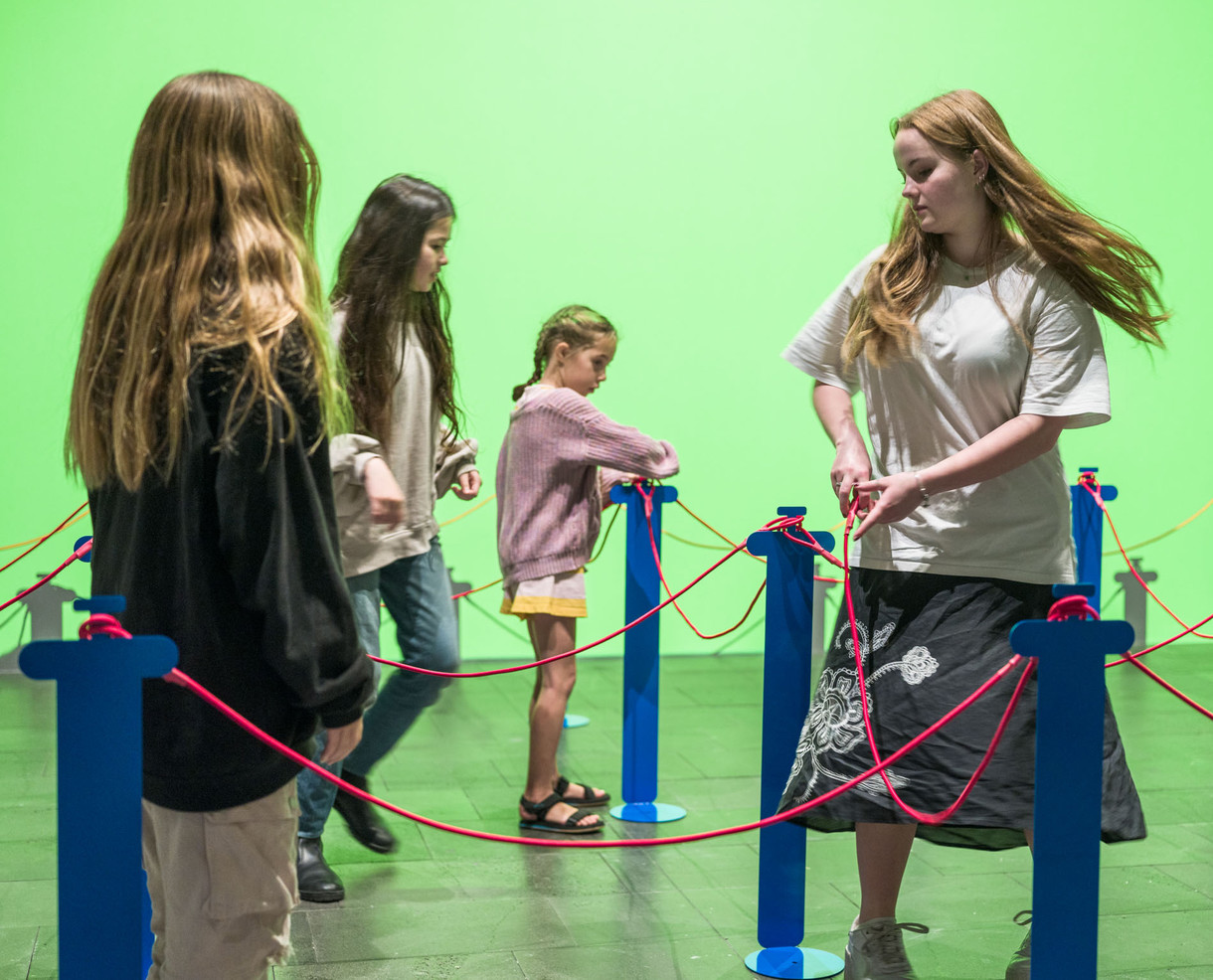Hard and Slippery – HAHAHA (Wait, is that the title?)
On naming things, collaboration as whanaukataka, and holding the door open for others
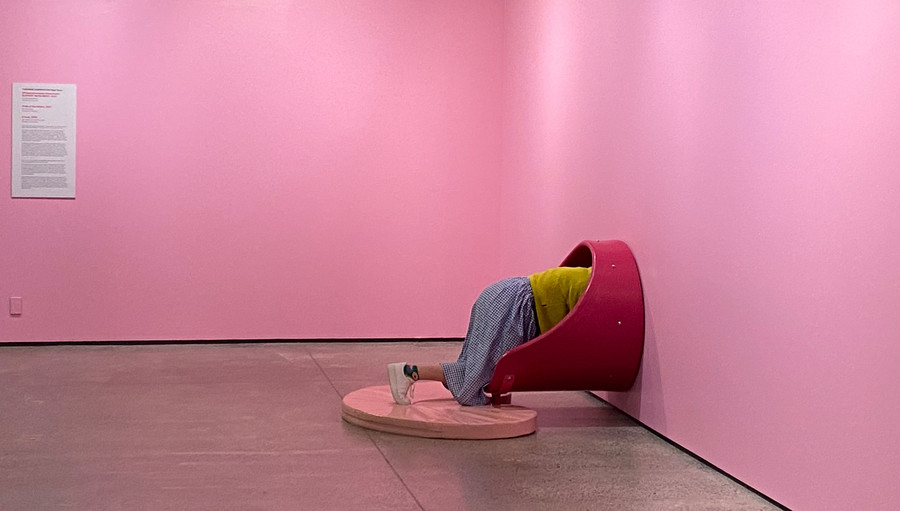
Turumeke Harrington Whakamaharataka Hāwaniwani SLIPPERY MONUMENT 2021. Installation view at Pataka Art + Museum. Photo: Ioana Gordon-Smith
Kommi: This is a courteous introductory message to the two of ya’ll and regarding the collab comms between Turumeke and I, and the editing of it by Kirsty, along with additional notes/commentary as like a third voice freaky irirangi concept (but in written/electronic messaging/note adding stuff form),* all towards the art concept workings and discussions in conversations leading to the finished arts ’n’ stuff resulting in a publication of our ponderings and explorations within te ao buzzy buzzy art stuff that we gonna do. I hope my whakamārama there was nice ’n’ clear.
Tui/Turumeke this is Kirsty. Kirsty, this is Tui/Turumeke.
Turumeke: Kia ora! Great articulation Kom!
Kirsty: Wait? Have we started? Was that a test? Hahaha
Kommi: I do not know.
A list of hard and slippery things: meaning-making, naming, interpretation, translation, creation, reclamation, collaboration.
Tuna.
Talking about art.
Sometimes you think you’ve finally got something (an idea, a name, a concept, a kupu) only for it to slide out from your grip, or out from under yourself entirely (shame). I feel like something of a slippery thing myself as I dip in and out of various kōrero between Turumeke and Kommi and other collaborators in my attempts to describe the artist’s forthcoming work Tātou tātou, nau mai rā set to be exhibited at Christchurch Art Gallery Te Puna o Waiwhetū. I slink between narratives that have inspired the piece(s) as well as those that are fertilising it – feeding it into existence (it being about manaakitanga amongst other things). This is not the first time I have asked myself: how did I get here? And what exactly am I supposed to be doing?
“It’s a vibe, man.”2
When I read these discussions, descriptions, conversations, and explanations pertaining to the wider body of Turumeke’s work and creative practice, and when I look at the works themselves, I start to think that those questions also sit underneath the mahi; so too, do notions of both hardness and slipperiness. Hardness, in terms of the difficulties and challenges that exist in, well, existing, as well as the feel of the material object. Slipperiness – between wor(l)ds, between English and te reo Māori, between seriousness and playfulness, between the private and public, between aesthetic and household object, between domestic and gallery spaces, between art and design, between the idea itself and the practicalities of bringing it into the world and having people experience it (amongst other things). But aren’t hardness and slipperiness also the necessary conditions for creation? (And did Rangi and Papa kinda flip the script on that?) Isn’t it the unknown in-between space where hardness and slipperiness, ah, come together, that is the most stimulating – the most generative?3
“Fuck me – talking about something that doesn’t exist is hard and especially when it isn’t just about you.”4
The task I’ve been given is to listen in on discussions about this upcoming work and to edit, cut and paste so others get to eavesdrop too – a curated conversation of sorts. But how do we discuss an idea that’s just beginning to germinate? (Cue the hardness and slipperiness again.) What do we even call this bit? Aha. This is where we start (and end, you’ll see): in the kōrero around the naming of things and in the way in which Turumeke and Kommi’s collaborative naming process is generative in and of itself; but first we have to go back, before we can go forward:
“An insight to our collaborative efforts speaks to what I think is valuable in/ from ‘The Arts’ generally – an ability to communicate stories, to be open to ‘magic’ (wassup te kore), to make fun and play and nonsense of things that are hard to comprehend or painful or boring and banal (like just regular being alive) and mainly a kind of whanaukataka – that in talking through ideas and names and kupu with you [Kommi] I get to practice one of the best parts of making shit, doing it and giving it and sharing it with others.”5
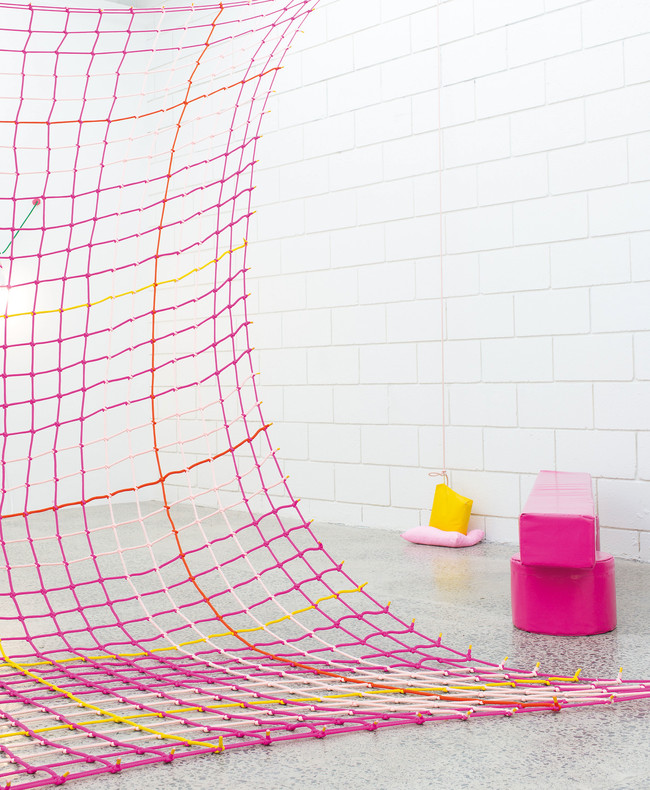
Installation view of Turumeke Harrington at Sumer Gallery, Tauranga, 2019. Image courtesy of Sumer Gallery
Turumeke: I thought we could start, Kommi, where all our conversations begin: with me trying to come up with a name for these new works. There are twelve lights, they’re going to be installed as part of Tauraka Toi at Dunedin Public Art Gallery. Rabbits, tuna, scallops, stars, tī kōuka. The idea that these lights are like fireplaces? Set up your house/ landing place; lights to make the place, delicious food resources, and a little dig at the old English: look at that saucy hare. Yum.
‘DINNER PLATES’, ‘HOT ROCKS’. Perhaps some idea that suggests resourcefulness, fuck you, or ... we could just get really sxxc and talk to the slippery nature of the tuna and the skinned hare and imagine them in the cosmos of stars [...] This is an interesting word ‘whakamārohirohi’ to harden, condition, tone up / fit, strong, resilient. What about ‘Whakamārohirohi (with hands like dinner plates)’; I wonder if I could find something that alluded to this: skinned / slippery /... and also jerking off / trying to get a ‘good keen southern man’ reference in. Now that I’m running through all the words too I wouldn’t mind having a dig at ‘resilience’ – some phrasing about peeling / cooking / slippery skin + resilience […]
Kommi: He pātaka mana hea (hea = hare lol) also play on pātaka as a food storehouse mana of the hare lol […] Maybe those twelve lights are not fires but twelve hearth stones to one fire. A word for hearth stones is pārua – which is also a brim, rim, bowl or depression in the ground for placing caught eels, or taro, etc… pā-rua to touch twice lol. Flick yer bean. Any more than two shakes and you’re playing with it […] HOT ROCKS – Kā kōhatu whakarekareka! Taken from ‘Kā kōhatu whakarekareka a Tamatea-pōkai whenua’ the hot sexy rocks or glowing rocks of Tamatea the traveller – the name for the Port Hills […] As you said ‘Whakamārohirohi’ yes! That’s it! Meaning to harden, condition, tone up and also to be resilient, fit and strong. In regards to peeling skin and teaming that up with the concept of resilience – Tui, I have no idea what you’re getting at. Artists these daaaaays. Oh wait Kirituna: that means to be hard-skinned
Turumeke: Aaaaaaaaaaaaaae.Here he’s come. Juicy maaayn.
![Turumeke Harrington You [I] Can’t Be (All Things To All Men) Chillout Sessions Vol. I–XIII 2021. Nylon, steel. Image courtesy Enjoy Contemporary Art Space. Photo: Cheska Brown](/media/cache/80/fc/80fc5b29cb0240fe0830c168558c84cf.jpg)
Turumeke Harrington You [I] Can’t Be (All Things To All Men) Chillout Sessions Vol. I–XIII 2021. Nylon, steel. Image courtesy Enjoy Contemporary Art Space. Photo: Cheska Brown
Āe, tino juicy this collaborative naming. And a process that brings forth new roots (and routes) reaching out and into and through the soil and muck connecting to the other things, both growing and dormant, out there, sustaining us, and holding us up. (Kia ora, Papatūānuku…)
The slippages and difficulties that permeate what we talk about and how we talk about it also underpin much of Turumeke’s work and the kōrero that continues to grow around the work too. What’s cool is that the ‘c’ word responsible for a lot of those slippages and difficulties isn’t the centre of things. It lingers, of course, but it isn’t jumping up and down at us, trying to get our attention. Rather it waits, arms folded, in the corner. (Time out for you. Stand there and think about what you’ve done.)
What is centred (the pito of the work?) is a commitment to figuring out the how and the why of us, and leaving something to help our babies have maybe (hopefully) an easier time of figuring that stuff out too: cross-generational manaakitanga in action. That whakapapa is everything – all the bits of us that come from all the places and the beauty and complexity and vibrancy and strangeness and humour within those bits – also underlies so much of the work. (I mean – of course it does with all its layers and foundations, metaphorical and otherwise.)
“I find the whole process of contextualising practice quite difficult because practice is – everything, all at once. It is whakapapa, blood lines and whatever. It’s also all of the work that I’m influenced by. [...] And simultaneously, all this work is about what it is to be a good person or what it is to respect and acknowledge the way, and how you got here...”6
Whakapapa too, and the pūrākau that accompany whakapapa, also branch ever outwards, like the process of naming; these too, Turumeke draws upon in both the practice and thinking through of potential projects, possible names – the seeds of things. But the work also gestures to – and is demonstrative of – those narratives and stories that we are yet to write ourselves and the names that we are yet to give each other; those that we will, some time in the future, create, sing, display and play with; these narratives that will then outlive us (ehara i te tī indeed).7 If we only live once, Turumeke’s mahi seems to say, why not try and make something cool with this life, strange little thing that it is? And why not make that something with and for others? Why not invite people in, hold the door open for others in the process?
It’s this making with and for – this collaboration not just in terms of the making of the thing before it gets to where it’s going, but the collaboration that occurs between artist(s) and those that experience the work – where both whanaungatanga and manaakitanga live. These are but two facets to Turumeke’s practice that are both subtle and overt; hidden and in plain sight (or site even). Furthermore, the representation and realisation of these values in the work are achieved by playful and serious means simultaneously. (Yes everything, all at once.)
“Because we are trying to learn together, what we talk about most is manaakitaka. In exhibition making, you can practice it”8
As I linger on the sidelines of the kōrero about the next work in progress, I see this door-holding – this gesture towards welcoming – being drawn upon in a different way; there is a playfulness going on here too and yes, once more, a slipperiness in terms of manaakitanga and the stories we tell ourselves about ourselves. Again, the collaborative naming process has its own offshoots that look out in every direction 9 – it has its own whakapapa, within which various whakaaro are reignited and revisited:
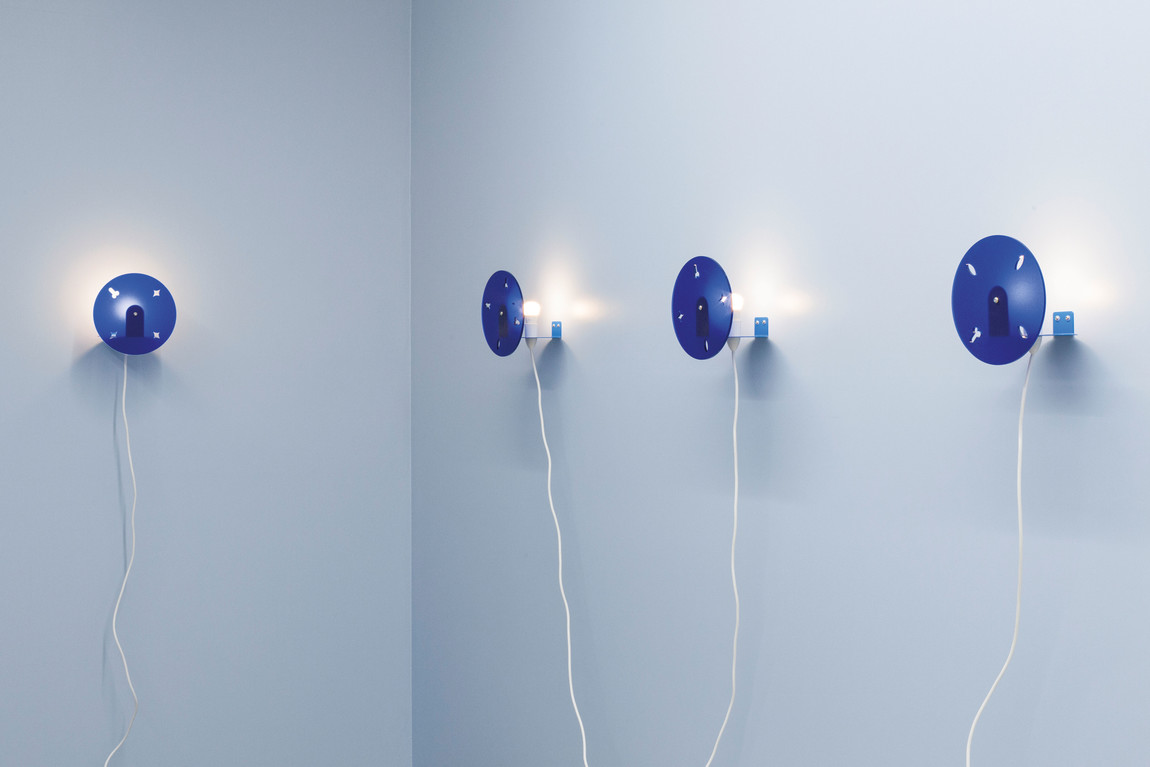
Turumeke Harrington Te Tauwhirowhiro Maruwehi (Can’t hold this sunny disposition back) I–XII 2021. Steel, acrylic perspex, LED light bulbs and electrical components. Image courtesy Enjoy Contemporary Art Space. Photo: Cheska Brown
Turumeke: The name… ‘Tātou tātou, nau mai rā’ … actually that feels like a place to start, or end, or … I think this name is weird in the context of all the names we have come up with. Usually they’re a reo-English pairing. Not translations. I’ve been looking back over our collabs [...] I feel like this happens a lot though, where you think you have had a radically new idea for yourself, or you feel like your work or thinking has moved greatly but really you keep coming back to the same ideas [...] I think maybe the precedent setter for the naming of work and shows is ‘Mahoranuiatea: Looking Out in Every Direction’. Which is where Matiaha Tiramōrehu is first directly referenced too. Maybe it’s interesting that the name for this project is ‘Tātou tātou, nau mai rā’ that it doesn’t recall from that same whakapapa or have the English companion to it. And that it could be interpreted very simply ‘we are all welcome’ When I imagine saying it though, I like to think there’s a sarcastic emphasis on the all. Coz we’re not.
Kommi: Okay, so yeah ‘Tātou, tātou, nau mai rā’ – it’s a real standard term, but not really. It comes across as like a generic greeting – but what it really is saying is like: ‘What’s yours is mine, g’, ‘what’s mine is yours’, ‘fuckin heeeellp yourself my baaraaau’ and ‘welcome welcome fellow weirdo’ [...] I think there’s nothing wrong with revisiting the same idea if it keeps on piquing your interest, if you are still exploring it, or even just obsessing over it, that’s good. It’s become part of who you are and what you do. Why deny yourself that?
Turumeke: Absolutely. It feels like each time around adding something more, learning and contributing, instead of doing or exploring an idea and that being that. Orbital! A little off centre! Interesting to imagine that when you’re as far away from one idea as you can be you’re on your way back there [...]
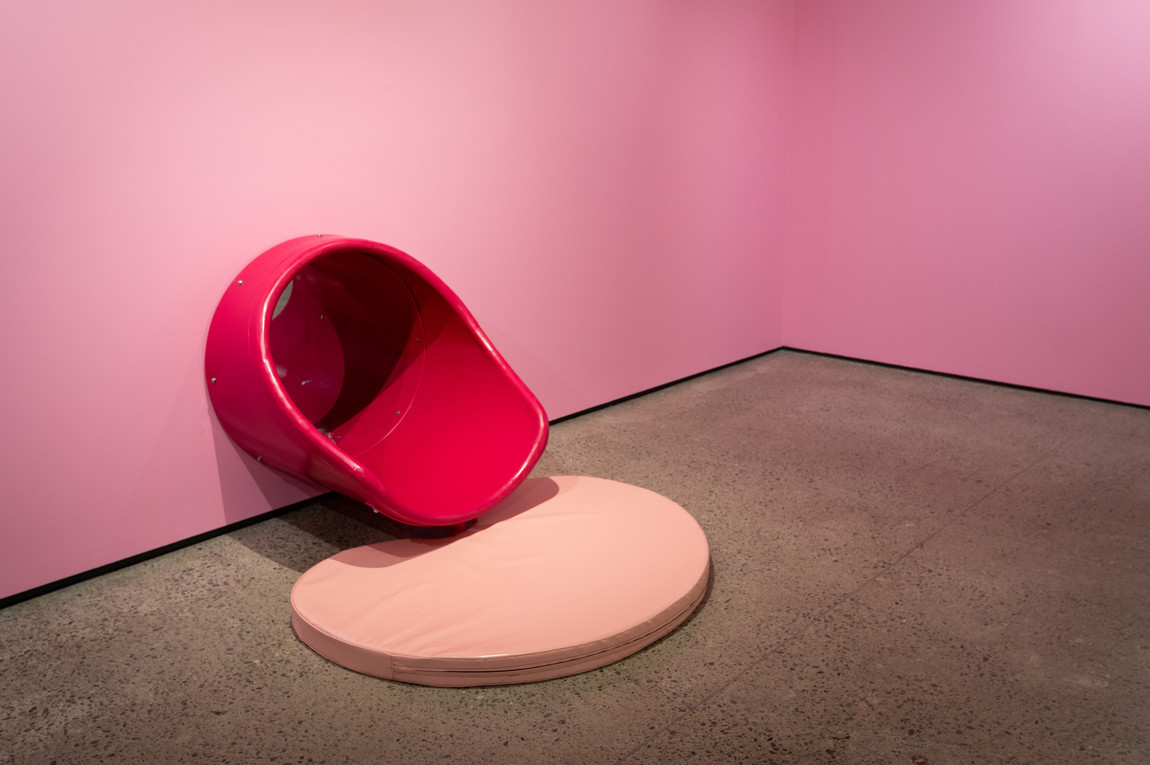
Turumeke Harrington Whakamaharataka Hāwaniwani
SLIPPERY MONUMENT 2021. Installation view at Pataka Art + Museum. Photo: Mark Tantrum
Back there indeed and once more asking myself, how did I get here? And what am I doing exactly?
“If you knew exactly what would happen at the end of everything, there would be very little fun in starting it at all.”10
Except now I’m seeing the questions from a slightly different perspective. The how did I get here is less about the being in the room itself and listening in on collaborative kōrero, but more about all those that came before me, that got me to this place (kia ora, e hoa). And less the what am I doing here, trying to make sense of art, and more in the sense of, now that I am here, now that I’ve been invited in, what am I going to do with this opportunity? Am I holding the door for someone else? (Kia ora, anō.)
“I’m working hard to welcome people in.
Like Whakamaharataka Hāwaniwani – literally welcoming people into the wall. Maybe described like te kore… into that liminal zone… be Māui and move through the tunnel / the tunnel is Māui / the tunnel is the birth canal…”11
Through the hard via the slippery, nē rā?








